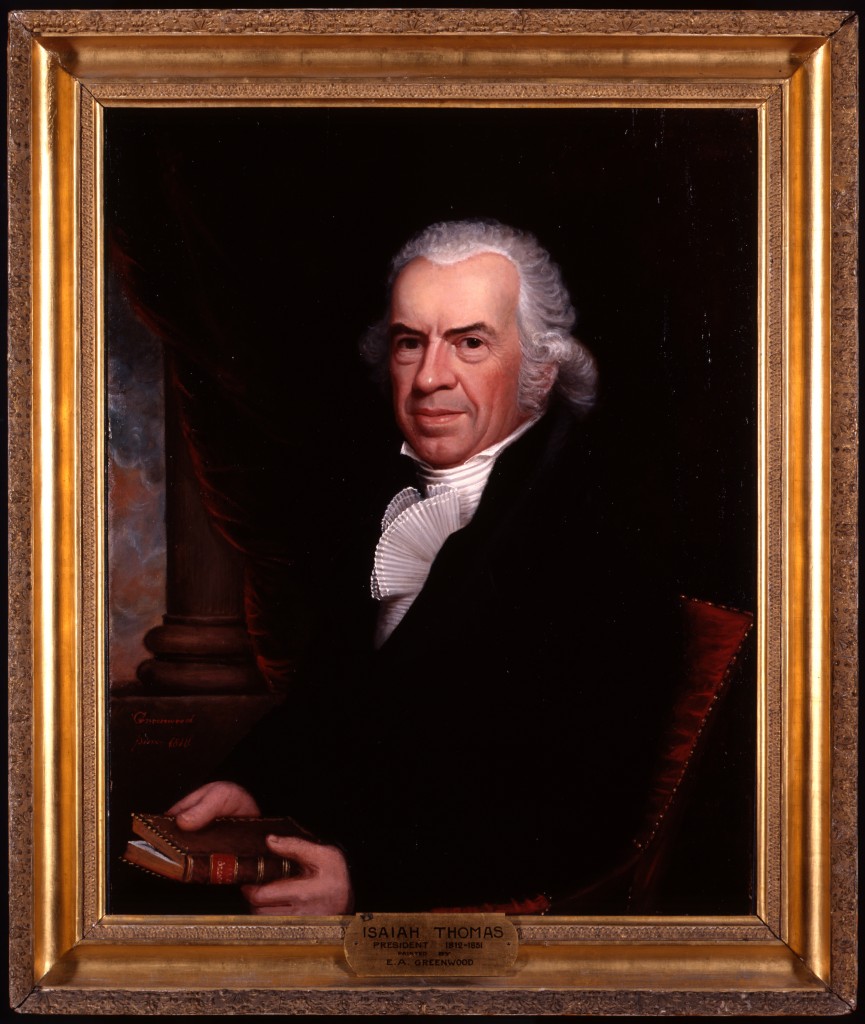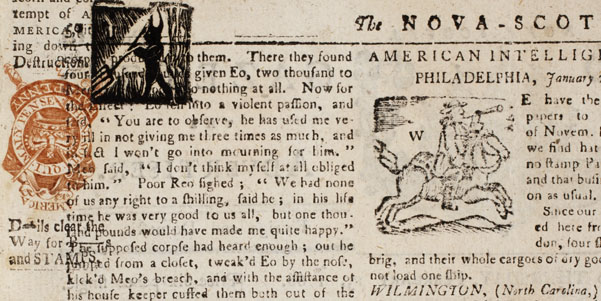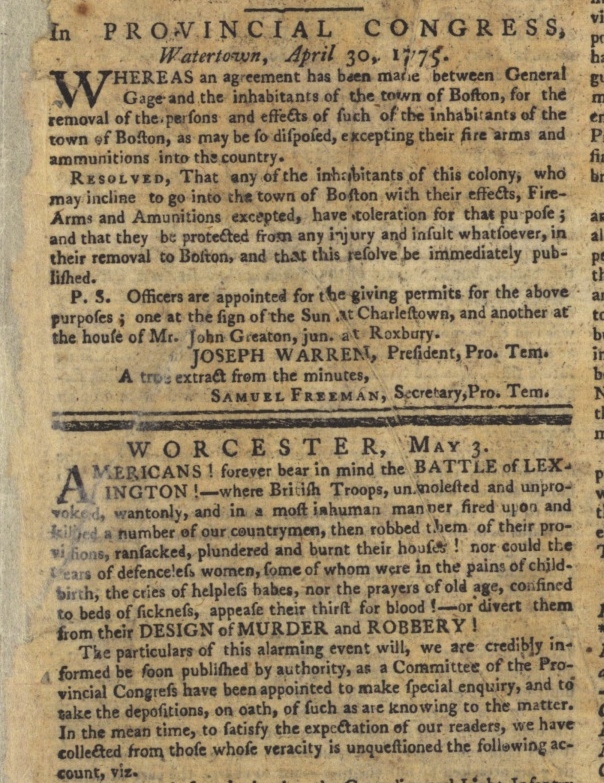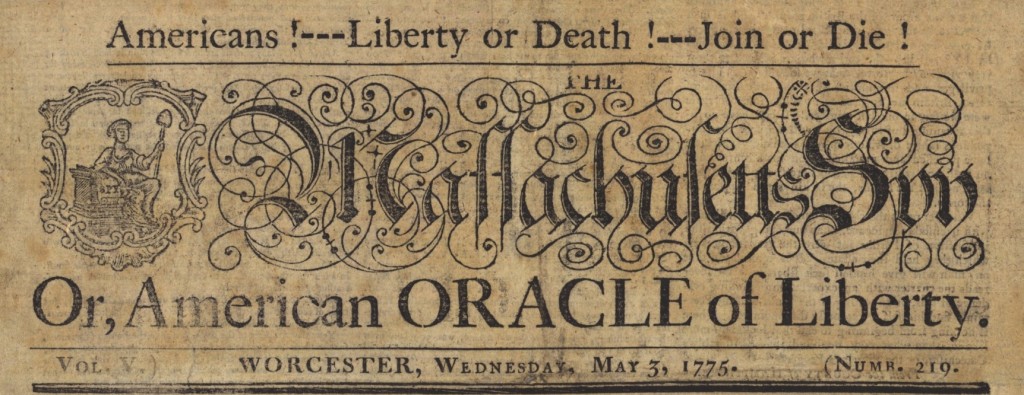
Here at AAS, nary a holiday goes by without some reflection on how the same was celebrated in days past. On this Fourth of July we’re going to take a trip back 200 years and check in on how our founder, Isaiah Thomas, celebrated the holiday.
In July 1814 the United States was in the midst of the War of 1812 with Britain. Many of the events we have come to most closely associate with the War of 1812—including the burning of Washington, D.C. and the composition of the Star Spangled Banner at the Battle of Baltimore—had yet to happen. Though the war was in many ways entering the beginning of the end—just the next month peace negotiations would begin in Ghent and would be finalized in December—this was not clear to Americans at the time. Thus, it was a war-weary and politically fractured populace that celebrated Independence Day in 1814.
Support for the war had been split from the beginning. The two major political parties at the time, the Federalist Party and the Democratic-Republican Party, were starkly opposed on the war. The older of the two, the Federal Party, had weakened in the recent years and remained strong mainly in the northeast. It supported strong central government and closer ties with Britain. The Democratic-Republicans favored a weaker central government, expansion, and a clearer independence from Britain. When Congress voted on the declaration of war in June 1812 no Federalists voted in favor, setting up a dichotomy that was to last throughout the war.
This opposition is clear in Isaiah’s account of the Fourth of July festivities in 1814. He begins his diary entry by stating simply, “Independence Celebrated by both political Parties, separately.” He goes on to explain that the “Federalists dined in a large Booth, on my land, near the north meeting house—The other party dined at Wheeler’s Tavern—Each formed in procession, and saluted each other as they passed—each had a military escort, and a band of Musick.—The federalists had their Exercises in the south Meeting house—the other in the north meeting house.” One begins to get a sense of how politics played a part in the town, not only ideologically, but also physically.

As this entry suggests by the mention of the Federalists dining on his land, Isaiah had never been one to keep his politics to himself. When he was just 16, he got himself into trouble with the authorities in Halifax, Nova Scotia, for printing items in the Halifax Gazette protesting the Stamp Act. First, it was a woodcut of the devil (which Isaiah made himself, of course) stabbing the official stamp with a pitchfork (see above). When he got in trouble for this he decided to get around the order not to do it again by simply reprinting copy from other newspapers, a common practice in the eighteenth century. This meant that he could print an article from the Pennsylvania Journal outlined in mourning borders and skulls announcing the death of the newspaper due to the Stamp Act and claim that he was simply sharing the news.

In the years leading up to the Revolutionary War, Isaiah’s newspaper, the Massachusetts Spy, transitioned from one “Open to ALL Parties, but Influenced by None,” to one that, by 1774, featured the slogan “JOIN OR DIE,” and eventually, “Americans!—Liberty or Death!—Join or Die!” The Spy became such an influential Patriot newspaper, in fact, that three days before the Battles of Lexington and Concord Isaiah smuggled his printing press out of Boston to Worcester for fear of it being impounded by the British authorities. On May 3 he printed his eyewitness account of the battles, a model of non-partisan journalism: “Americans! forever bear in mind the BATTLE of LEXINGTON! where British Troops, unmolested and unprovoked wantonly, and in a most inhuman manner fired upon and killed a number of our countrymen, then robbed them of their provisions, ransacked, plundered and burnt their houses! nor could the tears of defenseless women, some of whom were in the pains of childbirth, the cries of helpless, babes, nor the prayers of old age, confined to beds of sickness, appease their thirst for blood! – or divert them from their DESIGN of MURDER and ROBBERY!”
 Isaiah’s partisanship and rabble-rousing didn’t end with the Revolution. During late 1813 and early 1814, several British officers were taken prisoner in order to leverage an exchange for American soldiers and were paroled in Worcester. Isaiah, like many Federalists, believed these “hostages [of] government” were being mistreated and spent much time visiting them and bringing them extra comforts. In reality, their imprisonment was quite comfortable and when they found they were to be transferred elsewhere they bound and gagged the under-keeper and made their escape. Several were recaptured, but four remained free. Isaiah recorded the escape in his diary and noted that he had visited them earlier that day.
Isaiah’s partisanship and rabble-rousing didn’t end with the Revolution. During late 1813 and early 1814, several British officers were taken prisoner in order to leverage an exchange for American soldiers and were paroled in Worcester. Isaiah, like many Federalists, believed these “hostages [of] government” were being mistreated and spent much time visiting them and bringing them extra comforts. In reality, their imprisonment was quite comfortable and when they found they were to be transferred elsewhere they bound and gagged the under-keeper and made their escape. Several were recaptured, but four remained free. Isaiah recorded the escape in his diary and noted that he had visited them earlier that day.
With this record it comes as no surprise that the political parties celebrated Independence Day separately, nor that Isaiah was among the leaders on the Federalist side. Despite their separation, the two factions did observe some basic civilities, although whether these civilities were intended to be sincere or facetious is difficult to determine. As noted earlier, they saluted to each other as they crossed paths on their way to their respective meeting places, and later in the entry, Isaiah relates that “Two toasts were reciprocated—with a discharge of artillery—a Comee accompanied with a band of Music, waited one on the other party with the toasts.”
And lest we have any doubts about where Isaiah stood in his viewpoints (although at this point that seems unlikely), his closing statement for the entry erases them: “The federal party was the largest about 400, and really the most respectable.—dined with the Federalists.”

2 thoughts on “Isaiah Celebrates the Fourth of July”